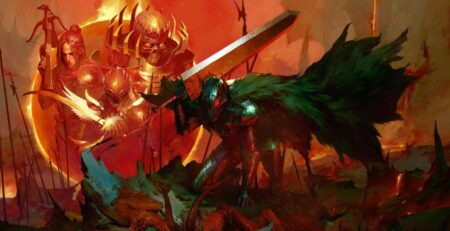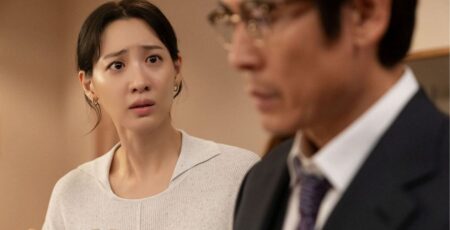For the full interview with Sam and Adam Deats, hit play on the audio player below.
Castlevania is a phenomenon. It’s a favorite for anime fans, gamers, vampire fans, and more. As one of the standard-bearers for Netflix Original Animations, Castlevania, from Powerhouse Animation, has come a long way from a four-episode first season and just as the season episode length has been slowly increasing, so have the character arcs. Now, just two weeks out from the release of Castlevania Season 4 –which is also the series’ final season– we got the chance to sit down with Samuel Deats (Director) and Adam Deats (Associate Director) to discuss the series’ journey. In this interview, Sam and Adam discuss their extensive roles as directors, how they came on board the project all those years ago, and how the series found its unique aesthetic.
Over the course of the interview Sam and Adam bring listeners through the history of Castlevania as an animated property from the rights being secured over a decade ago to Netflix coming in to start their original animations with Castlevania at the start of it. In that vein, the two also discuss how the series developed to naturally find its place among existing fans of the video game franchise (like they are) and those new to it.
On the topic Adam explained, “I feel like it happened on it’s own to an extent…On top of hitting the video game crowd, we’re also hitting the anime crowd just visually on top of that, And I hate to say it, there’s just a lot of people that really love f Richard Armitage’s voice. We really hit that mom segment of fans really well, they just love that guy. There are just really good working parts.” When you look at Castlevania fans, myself included, they really are diverse. Whether it’s because Armitage we might not know but, as Adam pointed out the series is able to speak multiple demographic in a way that other Netlflix adult-animation properties don’t.
Sam added, “Going in from the start, the goal was to make something that anyone could go in and watch and wasn’t something that required any prior knowledge. An I think that that’s something that is inherently beneficial to the property itself. You’re dealing with Dracula, and you’re dealing with vampires, and you’re dealing with monster hunters. You don’t need a whole lot of information walking into it. That said, both directors also show their attention to existing lore in the franchise – specifically the choice to begin the animated story at Castlevania 3, with the Belmonts, and growing it all from there.

In the same way that the series naturally took shape into a story that is easily accessible to existing fans and new viewers alike, Sam also explained that the series’ diversity also just came naturally, “It was something that we wanted to make sure that this story wasn’t just focused on this one tiny place or group of people, this is a worldwide event that was affecting everyone. Therefore, you’re gonna have people from all walks of life tied to it and affected by it. It was an active decision to bring in characters from various walks of life and various parts of the world…We wanted to make sure that this wasn’t just a story with just a lot of white people.” Adam interjects, “A very pale vampire show like many of them end up being.”
Beyond development of the story, Sam and Adam also discuss the beauty of the series’ characters, giving credit to the bi-shonen beauty that Ayami Kojima brought to the franchise in the 90s. “That was a fun thing to try and jump in and absorb as I started developing the look of the show in the beginning,” Sam said, “I really enjoy Ayami Kojima’s aesthetic and understanding it but also getting it to work with the tone of the show itself and finding that balancing act.”
And what’s that balancing act? A balance between brutality and beauty especially in a way not seen in other Western animated works. “In a sense, we accidentally ended up there, because we like to have fun during battle,” Adam explained, “We’re also trying to hit horror notes for sure in kinds of sequences, and that sometimes comes packed with a certain level of body-horror. A lot of the time, we’re not even taking it all that seriously, the gore part, because it’s all in the fun of the battle. In other instances the horror is supposed to feel as horrific as possible. Juxtaposing that with beautiful people? I don’t know, it’s one of those things that anime has been doing for a very long time,” Adam explained.
The duo also map out the journey the show has taken and how the series exploded just from the first teaser. “We absolutely had no idea that [Castlevania] was gonna take off. We were just so nervous because it was our first time working on a series and we were stumbling so much that first season trying to figure out how to make things happen.” Additionally, Adam added that the nervousness is still around to this day, “We’ve improved so much but I can tell you with certainty that the anxiety goes away. Every release you ask, ‘are they gonna like it?’ Even though all we did was release a poster.”
But beyond the impact of the show itself, Sam details how the team has researched folklore, looking for elements not brought to the screen before and changing them to adapt them to the Castlevania lore. He also breaks down the influences for the series and how the storytelling is about fitting to the spirit of the franchise, “In the same inspiration of how Castlevania looks backwards to those old folktales, we also look to contemporary horror,” Sam explained, “The method has been largely kind of following the original intent to what Castlevania has always been, cramming together all these different horror creatures and franchise from way back when and finding new places to pull inspiration from, and that’s something we’ve tried to continue in the show.”
Plus, Sam and Adam goes into detail about all the work that goes into battle sequences in the series, and how they avoid 3D elements largely, which leads to hand-drawn details in big sequences – like, you know, the big ball of bodies. “What you saw in season 3 is barely anything compared to what we’ve done for season 4,” Sam hints before explaining the large process of bringing sequences to life. Including Sam and Adam’s working on animation directly with the animators as well.
Finally, we discuss what Sam and Adam want fans to take away from the series as a whole, avoiding spoilers of course. “There have been continuous cycles of violence in the show for awhile. And there’s also been a central theme of reformation and whether that’s a worthwhile thing to ask of people,” Adam explained, “And that’s what the season’s about thematically. We’re going to hopefully answer that question or leave you with a bunch of questions and maybes.”
It’s clear the passion that goes into Castlevania just through this one interview. As you get ready for season 4 to drop next week, take some time to listen to the full interview in the media player above.
Castlevania Season 4 premieres exclusive on Netlflix May 14, 2021.
First look images of Castlevania Season 4 courtesy of Netflix












